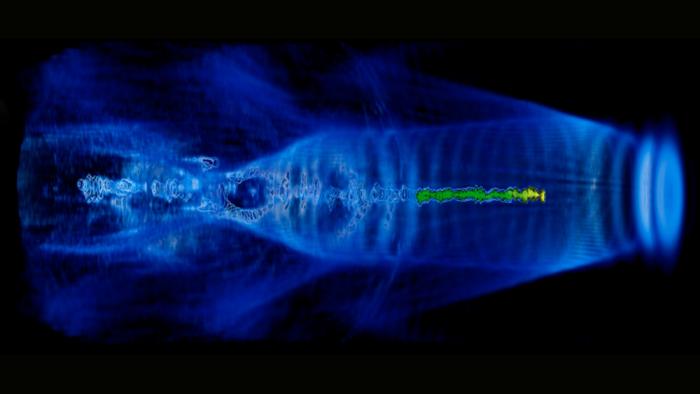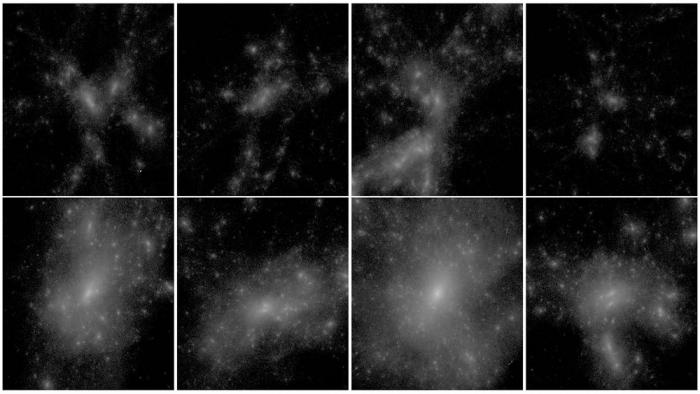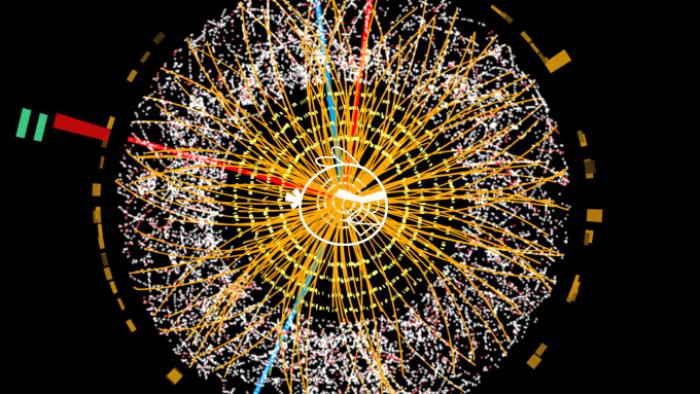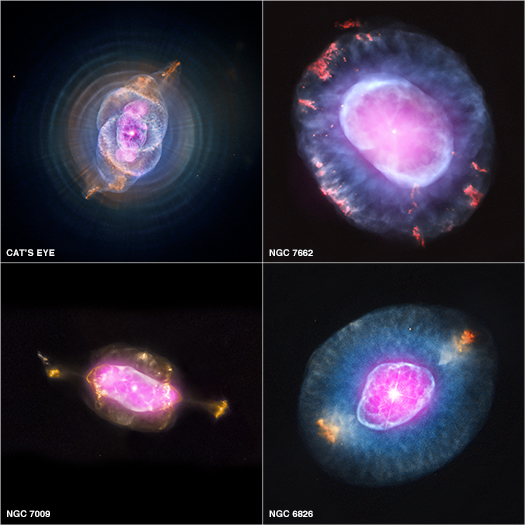Look At This: An X-Ray Diffraction Image of Martian Soil | 80beats
Updated: 2012-10-31 17:19:44
: Subscribe Today Renew Give a Gift Archives Customer Service Facebook Twitter Newsletter SEARCH Health Medicine Mind Brain Technology Space Human Origins Living World Environment Physics Math Video Photos Podcast RSS Numbers , Pictures , Climate Change : Stories From Sandy Look At This : An X-Ray Diffraction Image of Martian Soil This striking image represents the chemical composition of Martian sand recently collected by the Curiosity rover . Analysis of it reveals that Martian dirt is similar to volcanic soil from Hawaii , containing crystalline feldspar , pyroxene and olivine . To create this image , the rover’s Chemistry and Mineralogy CheMin instrument bombarded sand samples with X-rays , which bounce off in different patterns depending on the sample composition , allowing scientists

 CURRENT ISSUE THE MAGAZINE Current Issue Next Issue Back Issues Digital Editions Preview the Magazine Special Issues E-mail Newsletter About the Magazine Subscribe , Renew or Give a Gift Subscriber Benefits Trips Tours Advertise Advertiser Links Sweepstakes Press Room Contact Us COLUMNISTS Bob Berman Glenn Chaple Tony Hallas David H . Levy Stephen James O'Meara NEWS OBSERVING Astronomy News Liz and Bill's Cosmic Adventures Dave's Universe videos StarDome Plus Intro to the Sky Astronomy for Kids Urban Skies Astronomy Myths The Sky this Week The Sky this Month Star Atlas Ask Astro Astro Imaging Constellation Observing Glossary EQUIPMENT Products Reviews How To MULTIMEDIA Picture of the Day Reader Photo Gallery Videos Podcasts Wallpaper COMMUNITY Why Join Local Group Blog Dave's Universe
CURRENT ISSUE THE MAGAZINE Current Issue Next Issue Back Issues Digital Editions Preview the Magazine Special Issues E-mail Newsletter About the Magazine Subscribe , Renew or Give a Gift Subscriber Benefits Trips Tours Advertise Advertiser Links Sweepstakes Press Room Contact Us COLUMNISTS Bob Berman Glenn Chaple Tony Hallas David H . Levy Stephen James O'Meara NEWS OBSERVING Astronomy News Liz and Bill's Cosmic Adventures Dave's Universe videos StarDome Plus Intro to the Sky Astronomy for Kids Urban Skies Astronomy Myths The Sky this Week The Sky this Month Star Atlas Ask Astro Astro Imaging Constellation Observing Glossary EQUIPMENT Products Reviews How To MULTIMEDIA Picture of the Day Reader Photo Gallery Videos Podcasts Wallpaper COMMUNITY Why Join Local Group Blog Dave's Universe On July 4, scientists around the world popped open champagne bottles and toasted the culmination of nearly five decades of research. They had discovered a new particle, one that looked awfully similar to the long-sought Higgs boson.
The Higgs boson has for decades been the last missing piece of the Standard Model of particle physics. But even if the new particle completes the puzzle, some of its pieces still refuse to fit.
On July 4, scientists around the world popped open champagne bottles and toasted the culmination of nearly five decades of research. They had discovered a new particle, one that looked awfully similar to the long-sought Higgs boson.
The Higgs boson has for decades been the last missing piece of the Standard Model of particle physics. But even if the new particle completes the puzzle, some of its pieces still refuse to fit. CURRENT ISSUE THE MAGAZINE Current Issue Next Issue Back Issues Digital Editions Preview the Magazine Special Issues E-mail Newsletter About the Magazine Subscribe , Renew or Give a Gift Subscriber Benefits Trips Tours Advertise Advertiser Links Sweepstakes Press Room Contact Us COLUMNISTS Bob Berman Glenn Chaple Tony Hallas David H . Levy Stephen James O'Meara NEWS OBSERVING Astronomy News Liz and Bill's Cosmic Adventures Dave's Universe videos StarDome Plus Intro to the Sky Astronomy for Kids Urban Skies Astronomy Myths The Sky this Week The Sky this Month Star Atlas Ask Astro Astro Imaging Constellation Observing Glossary EQUIPMENT Products Reviews How To MULTIMEDIA Picture of the Day Reader Photo Gallery Videos Podcasts Wallpaper COMMUNITY Why Join Local Group Blog Dave's Universe
CURRENT ISSUE THE MAGAZINE Current Issue Next Issue Back Issues Digital Editions Preview the Magazine Special Issues E-mail Newsletter About the Magazine Subscribe , Renew or Give a Gift Subscriber Benefits Trips Tours Advertise Advertiser Links Sweepstakes Press Room Contact Us COLUMNISTS Bob Berman Glenn Chaple Tony Hallas David H . Levy Stephen James O'Meara NEWS OBSERVING Astronomy News Liz and Bill's Cosmic Adventures Dave's Universe videos StarDome Plus Intro to the Sky Astronomy for Kids Urban Skies Astronomy Myths The Sky this Week The Sky this Month Star Atlas Ask Astro Astro Imaging Constellation Observing Glossary EQUIPMENT Products Reviews How To MULTIMEDIA Picture of the Day Reader Photo Gallery Videos Podcasts Wallpaper COMMUNITY Why Join Local Group Blog Dave's Universe CURRENT ISSUE THE MAGAZINE Current Issue Next Issue Back Issues Digital Editions Preview the Magazine Special Issues E-mail Newsletter About the Magazine Subscribe , Renew or Give a Gift Subscriber Benefits Trips Tours Advertise Advertiser Links Sweepstakes Press Room Contact Us COLUMNISTS Bob Berman Glenn Chaple Tony Hallas David H . Levy Stephen James O'Meara NEWS OBSERVING Astronomy News Liz and Bill's Cosmic Adventures Dave's Universe videos StarDome Plus Intro to the Sky Astronomy for Kids Urban Skies Astronomy Myths The Sky this Week The Sky this Month Star Atlas Ask Astro Astro Imaging Constellation Observing Glossary EQUIPMENT Products Reviews How To MULTIMEDIA Picture of the Day Reader Photo Gallery Videos Podcasts Wallpaper COMMUNITY Why Join Local Group Blog Dave's Universe
CURRENT ISSUE THE MAGAZINE Current Issue Next Issue Back Issues Digital Editions Preview the Magazine Special Issues E-mail Newsletter About the Magazine Subscribe , Renew or Give a Gift Subscriber Benefits Trips Tours Advertise Advertiser Links Sweepstakes Press Room Contact Us COLUMNISTS Bob Berman Glenn Chaple Tony Hallas David H . Levy Stephen James O'Meara NEWS OBSERVING Astronomy News Liz and Bill's Cosmic Adventures Dave's Universe videos StarDome Plus Intro to the Sky Astronomy for Kids Urban Skies Astronomy Myths The Sky this Week The Sky this Month Star Atlas Ask Astro Astro Imaging Constellation Observing Glossary EQUIPMENT Products Reviews How To MULTIMEDIA Picture of the Day Reader Photo Gallery Videos Podcasts Wallpaper COMMUNITY Why Join Local Group Blog Dave's Universe : . Subscribe Today Renew Give a Gift Archives Customer Service Facebook Twitter Newsletter SEARCH Health Medicine Mind Brain Technology Space Human Origins Living World Environment Physics Math Video Photos Podcast RSS NCBI ROFL : Endometriosis : hot or not NCBI ROFL : Hotspots’ for aggression in licensed drinking . venues NCBI ROFL : Republican women look more feminine than . Democrats Appearance-based politics : Sex-typed facial cues communicate political party affiliation Consequential political judgments often rely on facial appearance , yet the facial cues that compel such judgments remain unspecified . We predicted that judgments of political party affiliation , and by extension their accuracy , rely on the sex-typicality of facial cues i.e . the degree of facial masculinity and
: . Subscribe Today Renew Give a Gift Archives Customer Service Facebook Twitter Newsletter SEARCH Health Medicine Mind Brain Technology Space Human Origins Living World Environment Physics Math Video Photos Podcast RSS NCBI ROFL : Endometriosis : hot or not NCBI ROFL : Hotspots’ for aggression in licensed drinking . venues NCBI ROFL : Republican women look more feminine than . Democrats Appearance-based politics : Sex-typed facial cues communicate political party affiliation Consequential political judgments often rely on facial appearance , yet the facial cues that compel such judgments remain unspecified . We predicted that judgments of political party affiliation , and by extension their accuracy , rely on the sex-typicality of facial cues i.e . the degree of facial masculinity and CURRENT ISSUE THE MAGAZINE Current Issue Next Issue Back Issues Digital Editions Preview the Magazine Special Issues E-mail Newsletter About the Magazine Subscribe , Renew or Give a Gift Subscriber Benefits Trips Tours Advertise Advertiser Links Sweepstakes Press Room Contact Us COLUMNISTS Bob Berman Glenn Chaple Tony Hallas David H . Levy Stephen James O'Meara NEWS OBSERVING Astronomy News Liz and Bill's Cosmic Adventures Dave's Universe videos StarDome Plus Intro to the Sky Astronomy for Kids Urban Skies Astronomy Myths The Sky this Week The Sky this Month Star Atlas Ask Astro Astro Imaging Constellation Observing Glossary EQUIPMENT Products Reviews How To MULTIMEDIA Picture of the Day Reader Photo Gallery Videos Podcasts Wallpaper COMMUNITY Why Join Local Group Blog Dave's Universe
CURRENT ISSUE THE MAGAZINE Current Issue Next Issue Back Issues Digital Editions Preview the Magazine Special Issues E-mail Newsletter About the Magazine Subscribe , Renew or Give a Gift Subscriber Benefits Trips Tours Advertise Advertiser Links Sweepstakes Press Room Contact Us COLUMNISTS Bob Berman Glenn Chaple Tony Hallas David H . Levy Stephen James O'Meara NEWS OBSERVING Astronomy News Liz and Bill's Cosmic Adventures Dave's Universe videos StarDome Plus Intro to the Sky Astronomy for Kids Urban Skies Astronomy Myths The Sky this Week The Sky this Month Star Atlas Ask Astro Astro Imaging Constellation Observing Glossary EQUIPMENT Products Reviews How To MULTIMEDIA Picture of the Day Reader Photo Gallery Videos Podcasts Wallpaper COMMUNITY Why Join Local Group Blog Dave's Universe CURRENT ISSUE THE MAGAZINE Current Issue Next Issue Back Issues Digital Editions Preview the Magazine Special Issues E-mail Newsletter About the Magazine Subscribe , Renew or Give a Gift Subscriber Benefits Trips Tours Advertise Advertiser Links Sweepstakes Press Room Contact Us COLUMNISTS Bob Berman Glenn Chaple Tony Hallas David H . Levy Stephen James O'Meara NEWS OBSERVING Astronomy News Liz and Bill's Cosmic Adventures Dave's Universe videos StarDome Plus Intro to the Sky Astronomy for Kids Urban Skies Astronomy Myths The Sky this Week The Sky this Month Star Atlas Ask Astro Astro Imaging Constellation Observing Glossary EQUIPMENT Products Reviews How To MULTIMEDIA Picture of the Day Reader Photo Gallery Videos Podcasts Wallpaper COMMUNITY Why Join Local Group Blog Dave's Universe
CURRENT ISSUE THE MAGAZINE Current Issue Next Issue Back Issues Digital Editions Preview the Magazine Special Issues E-mail Newsletter About the Magazine Subscribe , Renew or Give a Gift Subscriber Benefits Trips Tours Advertise Advertiser Links Sweepstakes Press Room Contact Us COLUMNISTS Bob Berman Glenn Chaple Tony Hallas David H . Levy Stephen James O'Meara NEWS OBSERVING Astronomy News Liz and Bill's Cosmic Adventures Dave's Universe videos StarDome Plus Intro to the Sky Astronomy for Kids Urban Skies Astronomy Myths The Sky this Week The Sky this Month Star Atlas Ask Astro Astro Imaging Constellation Observing Glossary EQUIPMENT Products Reviews How To MULTIMEDIA Picture of the Day Reader Photo Gallery Videos Podcasts Wallpaper COMMUNITY Why Join Local Group Blog Dave's Universe , , CURRENT ISSUE THE MAGAZINE Current Issue Next Issue Back Issues Digital Editions Preview the Magazine Special Issues E-mail Newsletter About the Magazine Subscribe , Renew or Give a Gift Subscriber Benefits Trips Tours Advertise Advertiser Links Sweepstakes Press Room Contact Us COLUMNISTS Bob Berman Glenn Chaple Tony Hallas David H . Levy Stephen James O'Meara NEWS OBSERVING Astronomy News Liz and Bill's Cosmic Adventures Dave's Universe videos StarDome Plus Intro to the Sky Astronomy for Kids Urban Skies Astronomy Myths The Sky this Week The Sky this Month Star Atlas Ask Astro Astro Imaging Constellation Observing Glossary EQUIPMENT Products Reviews How To MULTIMEDIA Picture of the Day Reader Photo Gallery Videos Podcasts Wallpaper COMMUNITY Why Join Local Group Blog Dave's Universe
, , CURRENT ISSUE THE MAGAZINE Current Issue Next Issue Back Issues Digital Editions Preview the Magazine Special Issues E-mail Newsletter About the Magazine Subscribe , Renew or Give a Gift Subscriber Benefits Trips Tours Advertise Advertiser Links Sweepstakes Press Room Contact Us COLUMNISTS Bob Berman Glenn Chaple Tony Hallas David H . Levy Stephen James O'Meara NEWS OBSERVING Astronomy News Liz and Bill's Cosmic Adventures Dave's Universe videos StarDome Plus Intro to the Sky Astronomy for Kids Urban Skies Astronomy Myths The Sky this Week The Sky this Month Star Atlas Ask Astro Astro Imaging Constellation Observing Glossary EQUIPMENT Products Reviews How To MULTIMEDIA Picture of the Day Reader Photo Gallery Videos Podcasts Wallpaper COMMUNITY Why Join Local Group Blog Dave's Universe . . . Subscribe Today Renew Give a Gift Archives Customer Service Facebook Twitter Newsletter SEARCH Health Medicine Mind Brain Technology Space Human Origins Living World Environment Physics Math Video Photos Podcast RSS Saturn storm cranks the heat WAY up Hurricane Sandy looms over the US Oh . Well . I feel pretty awful about . this They had to get their ideas from somewhere Via FlickFilosopher Related : posts FELIXTERMINATE PRECIPITATE PRECIPITATE CONFLAGRATE CONFLAGRATE EXTIRPATE Extermiknit Part II Trick or geek Share October 26th , 2012 9:43 AM Tags : Daleks Doctor Who by Phil Plait in Uncategorized 21 comments RSS feed Trackback 21 Responses to Oh . Well . I feel pretty awful about this . 8221 1. Larry Says : October 26th , 2012 at 10:07 am Destroy Destroy Destroy Is that a little
. . . Subscribe Today Renew Give a Gift Archives Customer Service Facebook Twitter Newsletter SEARCH Health Medicine Mind Brain Technology Space Human Origins Living World Environment Physics Math Video Photos Podcast RSS Saturn storm cranks the heat WAY up Hurricane Sandy looms over the US Oh . Well . I feel pretty awful about . this They had to get their ideas from somewhere Via FlickFilosopher Related : posts FELIXTERMINATE PRECIPITATE PRECIPITATE CONFLAGRATE CONFLAGRATE EXTIRPATE Extermiknit Part II Trick or geek Share October 26th , 2012 9:43 AM Tags : Daleks Doctor Who by Phil Plait in Uncategorized 21 comments RSS feed Trackback 21 Responses to Oh . Well . I feel pretty awful about this . 8221 1. Larry Says : October 26th , 2012 at 10:07 am Destroy Destroy Destroy Is that a little In Wim Leemans’ lab at Lawrence Berkeley National Laboratory sits one of the world’s most advanced R&D accelerators. By pushing electrons forward on the crest of plasma waves, the accelerator is capable of accelerating electron bunches from an energy of 0 to 1 billion electronvolts in just 3 centimeters. But, until now, Leemans and his team were unable to quantify exactly how uniform that acceleration was within a bunch of electrons. This measurement is especially important for one of the most promising applications of plasma accelerators: free-electron lasers.
In Wim Leemans’ lab at Lawrence Berkeley National Laboratory sits one of the world’s most advanced R&D accelerators. By pushing electrons forward on the crest of plasma waves, the accelerator is capable of accelerating electron bunches from an energy of 0 to 1 billion electronvolts in just 3 centimeters. But, until now, Leemans and his team were unable to quantify exactly how uniform that acceleration was within a bunch of electrons. This measurement is especially important for one of the most promising applications of plasma accelerators: free-electron lasers. Seeking less costly, more efficient means of particle acceleration, physicists are developing new types of machines that zip particles to high energies in short distances. One promising method harnesses the power of plasma, accelerating electron bunches on the crest of plasma waves. Physicists recently discovered a way to measure the focus of such a beam, despite the fact that the plasma would melt traditional diagnostic tools.
Seeking less costly, more efficient means of particle acceleration, physicists are developing new types of machines that zip particles to high energies in short distances. One promising method harnesses the power of plasma, accelerating electron bunches on the crest of plasma waves. Physicists recently discovered a way to measure the focus of such a beam, despite the fact that the plasma would melt traditional diagnostic tools. Gravitational waves were first predicted by Albert Einstein almost a century ago, but scientists have yet to observe them directly.
Gravitational waves were first predicted by Albert Einstein almost a century ago, but scientists have yet to observe them directly. Scientists from the groups of professors Risa Wechsler and Tom Abel at the Kavli Institute for Particle Astrophysics and Cosmology, an institute run jointly by Stanford University and SLAC National Accelerator Laboratory, are busily crafting enough computer simulation tools to outfit a major stadium tour—if simulations were musical instruments and the KIPAC scientists a supergroup. They’ve managed to meld their different strains of software into the type of melody that dark matter just might dance to.
Scientists from the groups of professors Risa Wechsler and Tom Abel at the Kavli Institute for Particle Astrophysics and Cosmology, an institute run jointly by Stanford University and SLAC National Accelerator Laboratory, are busily crafting enough computer simulation tools to outfit a major stadium tour—if simulations were musical instruments and the KIPAC scientists a supergroup. They’ve managed to meld their different strains of software into the type of melody that dark matter just might dance to. CERN and Angry Birds-creator Rovio announced last Friday that they will team up to produce a learning program for children between 3 and 8 years old.
The partnership will focus on the Angry Birds Playground brand, which is designed to make learning about physics fun and accessible for all ages. It is based on Finland’s national kindergarten curriculum.
CERN and Angry Birds-creator Rovio announced last Friday that they will team up to produce a learning program for children between 3 and 8 years old.
The partnership will focus on the Angry Birds Playground brand, which is designed to make learning about physics fun and accessible for all ages. It is based on Finland’s national kindergarten curriculum. CURRENT ISSUE THE MAGAZINE Current Issue Next Issue Back Issues Digital Editions Preview the Magazine Special Issues E-mail Newsletter About the Magazine Subscribe , Renew or Give a Gift Subscriber Benefits Trips Tours Advertise Advertiser Links Sweepstakes Press Room Contact Us COLUMNISTS Bob Berman Glenn Chaple Tony Hallas David H . Levy Stephen James O'Meara NEWS OBSERVING Astronomy News Liz and Bill's Cosmic Adventures Dave's Universe videos StarDome Plus Intro to the Sky Astronomy for Kids Urban Skies Astronomy Myths The Sky this Week The Sky this Month Star Atlas Ask Astro Astro Imaging Constellation Observing Glossary EQUIPMENT Products Reviews How To MULTIMEDIA Picture of the Day Reader Photo Gallery Videos Podcasts Wallpaper COMMUNITY Why Join Local Group Blog Dave's Universe
CURRENT ISSUE THE MAGAZINE Current Issue Next Issue Back Issues Digital Editions Preview the Magazine Special Issues E-mail Newsletter About the Magazine Subscribe , Renew or Give a Gift Subscriber Benefits Trips Tours Advertise Advertiser Links Sweepstakes Press Room Contact Us COLUMNISTS Bob Berman Glenn Chaple Tony Hallas David H . Levy Stephen James O'Meara NEWS OBSERVING Astronomy News Liz and Bill's Cosmic Adventures Dave's Universe videos StarDome Plus Intro to the Sky Astronomy for Kids Urban Skies Astronomy Myths The Sky this Week The Sky this Month Star Atlas Ask Astro Astro Imaging Constellation Observing Glossary EQUIPMENT Products Reviews How To MULTIMEDIA Picture of the Day Reader Photo Gallery Videos Podcasts Wallpaper COMMUNITY Why Join Local Group Blog Dave's Universe Every year, particle accelerators play an essential role in scientific discovery, industry and even medicine. But what does it take to make an accelerator run? This video, produced by SLAC National Accelerator Laboratory, takes you into the department that builds klystrons, the devices that propel particles to nearly the speed of light within SLAC’s accelerators.
Every year, particle accelerators play an essential role in scientific discovery, industry and even medicine. But what does it take to make an accelerator run? This video, produced by SLAC National Accelerator Laboratory, takes you into the department that builds klystrons, the devices that propel particles to nearly the speed of light within SLAC’s accelerators.  This type of detector may have a futuristic name, but it already has a spot in the history of particle physics.
This type of detector may have a futuristic name, but it already has a spot in the history of particle physics. This gallery shows four planetary nebulas from the first systematic survey of such objects in the solar neighborhood made with NASA's Chandra X-ray Observatory.
This gallery shows four planetary nebulas from the first systematic survey of such objects in the solar neighborhood made with NASA's Chandra X-ray Observatory. The Royal Swedish Academy of Sciences has awarded the 2012 Nobel Prize in physics to two scientists who developed groundbreaking experimental methods that are the first steps toward building a new type of supercomputer known as a quantum computer. Their research has also led to the construction of extremely precise clocks that may replace present-day atomic clocks.
The Royal Swedish Academy of Sciences has awarded the 2012 Nobel Prize in physics to two scientists who developed groundbreaking experimental methods that are the first steps toward building a new type of supercomputer known as a quantum computer. Their research has also led to the construction of extremely precise clocks that may replace present-day atomic clocks.